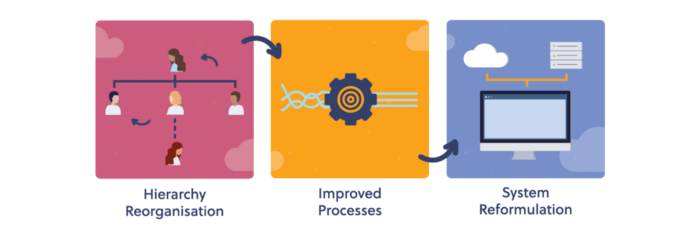
The Design Role in Digital Transformation
December 2, 2020
As the world keeps evolving and digital becomes more crucial to our everyday life, companies are feeling pressured to keep up and level up their game.
Although digital transformation has been on the spotlight for some time now, there are still a lot of organisations that need to plan for this type of initiative if they want to keep their competitive advantage towards their competitors and don’t lose market share.
With the pandemic, a lot of organisations had to completely change their way of working, in order to be able to stay open and have everyone working from home.
This unexpected life changing event pushed organisations into a forced digital transformation initiative. Some even say, that Covid-19 made companies flash forward 10 years when it comes to adapting to new ways of working.
But although these companies have already started to get on track and upgrading their way of working, specially moving to online tools to help with collaboration and working from home, let’s not forget that a proper initiative may take longer than a year to analyse, set strategies and consolidate the new processes.

Remember, switching your document management system to digital is not enough for a company to consider they were successful in an initiative of this kind, it only means you digitised your company.
What is Digital Transformation?
Before going further inside the theme, let’s define what is digital transformation. Different enterprises have slightly different ways to define it but I really enjoy this one from Salesforce:
“Digital transformation is the process of using digital technologies to create new — or modify existing — business processes, culture, and customer experiences to meet changing business and market requirements.”
Salesforce
There is a set of drivers that push companies into a digital transformation. Those are: customers, competition, data, innovation and value.
- Continuing to be relevant for the existing customers, making sure you are still the best option in the market and no competitor has surpassed you in innovation.
- Collecting more data about your clients’ needs and information on your enterprise from different departments, thanks to IoT, or other relevant technologies for your field, will increase the amount of information you have and allow you to improve your judgement when it comes to decision making, improving your company value in the end.
- Reducing your organisation costs through some changes, specially by switching legacy systems with new improved systems and cut on maintenance licensing, will allow your company to be more efficient and flexible to new opportunities in the market.
What will you gain with a Digital Transformation initiative?
In case your company is still not convinced on why they should undertake this initiative, this is the section you should send your boss.
Increased Process Efficiency
An increased efficiency can be achieved in 3 steps: hierarchy reorganisation, improved processes and system reformulation.

One of the biggest changes that may come with digital transformation is a hierarchical reorganisation. In order to maximise the results, your organisation will have to make sure in-house talents are in the right position, if not they should switch positions.
With the technological structure changes, fresh talent may come along to close the gap in key specialised positions.
After having set a new hierarchical disposition it’s time to move on to the processes. It is critical that the existing processes are rethought and, when needed, create new ones.
Last but definitely not least, by combining the previous steps with a new technological structure that allows your employees to collaborate in real time as well as to have access to critical information at all times, you will increase the efficiency of the company.
More accurate & faster decision making (data supported)
Continuing with the previous theme, as you improve the processes you will also be able to provide much more real time information to the top tiers of your company allowing them to have a more accurate and fast decision supported on data.
Customer centricity (higher conversion)
Digital transformation initiatives have your customer as a focal point. In case this is still not your modus operandi, it will be from now on. Why should your customer be at the centre of your strategy? Well, your customer will define your success or your failure, so it’s important for you to make sure you stay relevant to them and try to anticipate their needs through time as well as adapt when new opportunities arise. If you don’t pay attention to their needs, and try to provide personalised services, some other company may be on to this and surpass you.
Improved financial performance
Undertaking a digital transformation plan will improve your company’s financial performance in two different stages: system reformulation and profits increase.
By reducing costs with old licensing plans and several legacy systems that may no longer be required as you switched to improved systems. You will also cut on maintenance licensing regarding servers that you’ll no longer need as you will move some of your systems to the cloud.
This will increase your margin, that combined with better conversions from customers will globally improve your annual profit.
Design as a key point for Digital Transformation success
Now that we spoke about the digital transformation process, let’s move on to why design should be taken in consideration from day 1. It’s time the design team gets a place in the big players table as it can provide enriched know how on user experience that ultimately will enrich the full experience.
Why is design essential in a Digital Transformation initiative?
Design can unlock the full potential of a product or a service through different subjects within design. As we established above, the users need to become the centre of the companies, if we want to unlock the full potential and be sure to have a competitive advantage. User experience is by thus, one of the most important subjects to start using in these types of initiative as the researchers are specialised in understanding the users in their “natural habitat” when using the platforms, and are able to identify known and unknown pain points as well as identify opportunities through users wishes.
We live in a time where people expect to have personalised experiences with their loyal brands and to have their needs solutioned, sometimes even before they knew they needed something. Personalisation and forward thoughts are mandatory to maintain relevance at all times. By putting your customer first and study their behaviours, you will have the ability to anticipate their needs and, continually evolve your products without extra efforts, being open to undertake whatever new opportunities that may arise.
Design thinking may seem as a “cliché keyword” for the companies, but other than fitting nicely in your process description it actually provides valuable insights. Specially if you bring to a workshop different stakeholders, from different levels and departments. The most diverse the group, the more enriched insights you get.
After a few rounds of ideation, you’ll be able to define which are the issues to tackle and start thinking about solutions and testing them. You will be surprised on how some issues exist that you didn’t knew about! This is teamwork at its best. Do this a few cycles and you’ll find the best solutions for each of them.
If your company provides services it will also be really interesting to evaluate the state of your service flow in all its channels and understand which pain points exist and how you can resolve them, as well as what new opportunities exist that you can tackle. This is where service design can be key for your structure. Never underestimate your service flow as a whole, as its strength is as strong as the weakest channel you have. Users expect a seamless experience through traditional and digital channels, and they should complement themselves, not create confusion for their users.
Where it enriches the initiative
We’ve talked about what design can bring to the table in a generic way. It’s also important to talk about the improvements that design can bring to specific steps in a digital transformation initiative.
Strategy definition
Design can be an important tool from day one of the strategy definition. By applying different design fields in different stages of the process, you’ll have a stronger final product.
With user experience it’s possible to better understand the needs of your clients as well as your employees. By doing a heuristic evaluation and functionality analysis there is room to better understand your company value and competitive advantage that will be key throughout the process. You will be able to define journeys for each type of actor and used channel and have fresh insights about pain points and opportunities to improve your processes. It will definitely show you the bigger picture that normally isn’t that obvious for the majority of the C-level, helping to make the best decisions in this transformation process.
By applying Service Design methods, you guarantee that when your company processes are reorganised, it’s done in the most efficient way and optimises your service in all its channels equally, making it a seamless experience for the end user.
With process reorganisation it’s important to think about each team value and if needed, redefine teams by making sure that specific specialties are being dealt by the most indicated employee. These changes will also help break silos between departments, improving interdepartmental communication and duplicating the different feedback given in each project.

To end this process reformulation, it’s key to understand which technological partners still makes sense to maintain and which to change for new, more optimised and updated partners with different models of licensing. It will be fundamental so that the reformulated processes are fully efficient as designed.
How do you communicate this process to your employees and clients?
Great question! You thought I wasn’t going to mention graphic design? Well, think again.
When everything else is set, you still need to think about a way to continually communicate all the changes to everyone and you should do it by starting with a Visual restructuration that is aligned with your new vision.
You should also design user friendly portals that your employees and clients (if needed) can visit to keep track of news, such as an Initiative Portal. Also, a Training portal is going to be key to reduce the learning curve for the employees. It will be a safe space where they can see tutorials on using the new tools and study new processes, all at their own pace.
You see? Design is fundamental for a digital transformation initiative. The companies that already understood this and are bringing design to the “big league” table are getting ahead of their competitors.
Hope you are ready to embark in a digital transformation journey championing that a design team is mandatory for the success of your initiative!
By Rita Gomes da Silva
Need help with an initiative of this kind?
At Xperienz we have a specialised team in UX and UI as well as Digital Transformation initiatives. We can help you bridge the business unit requirements with our design team production to create exactly what your company needs.
Tell me moreRelated Articles
-
Looking to be EAA compliant? — Don’t fall for easy web accessibility solutions
Choosing an overlay is just a band-aid solution, and shows a true disregard for users with disabilities. Instead, we need to work towards a mentality where websites, apps and other digital products are designed and coded with accessibility in mind from day 1.
-
Prompt-based — The birth of a new human-machine interaction model
The ways humans interact with technology has evolved significantly over the decades — and it’s still constantly evolving. The rise of Artificial Intelligence (AI) and natural language processing (NPL) has brought to light a new way of interaction — prompts.
-
A glimpse into the future — Here’s the UX design trends we expect to dominate 2024
Emerging technologies and tools constantly influence the way people use the Internet and interact with digital products. And as user behaviours and preferences evolve, designers must keep up with new tools and solutions to deliver interfaces and user experiences that cater the needs of an ever-demanding audience.
-
How can insurance companies make their digital products more accessible?
Millions of people who live with a disability struggle to access important information online because websites and apps are built with major content and technological barriers. And insurance websites are not an exception.
-
Barrier-free banking - From branches to mobile apps accessible for all
In the banking and financial industry, accessibility is about empowering everyone, including people with disabilities and the elderly, to enjoy bank's products, services and facilities, by making them convenient and easy to use.
-
Design for a better world - How working together and applying design approaches is improving people's lives
9 November is World Usability Day 2023. This year's theme is Collaboration and Cooperation, which intents to focus on how we can work together to create solutions, both globally and locally, to solve the world's biggest problems.
-
Be an Agent of Change - Check these resources to help you build more ethical designs
The role of today's designer goes far beyond simply creating beautiful interfaces and experiences. You can no longer design without considering the consequences of how what you're creating impacts individuals, society and the world.
-
E-commerce and Accessibility - Creating an inclusive online shopping experience
Now it’s the time for online stores to improve their website accessibility and ensure they offer an inclusive experience for everyone.
-
The future is today — How can we leverage AI to improve our UX Design work
AI has now become a big part of several areas of our lives, and UX Design is no exception. It’s actually becoming more and more applicable to the UX design process.
-
Accessibility Compliance App - by Xperienz. A useful tool when fixing accessibility errors
To simplify the presentation of the accessibility evaluation of websites, Xperienz has created the Accessibility Compliance App. We start by doing a content inventory in which we collect all the pages of the site. Then we evaluate each page and list all the aspects that need to be fixed.
-
What does the UX future hold? - Here's the UX Design trends we expect to dominate 2023
Businesses must stay up to date on emerging user experience and interface trends so we've selected 7 top trends that are already making, and will certainly continue to make, an impact on website and app development.
-
Raising Awareness for Web Accessibility [Infographic] — International Day of Persons with Disabilities
Last December 3 we celebrated the International Day of Persons with Disabilities. To help promote a more accessible Web we’ve put together an easy-to-digest infographic about Web Accessibility.
-
Why hiring external UX services even when you have an in-house UX team?
Even if you have an in-house UX design team, there might be times when additional resources and professional know-how can be useful. Bringing in an external UX team might be exactly what you need for your company to excel in all projects.
-
Health and UX: when design has a life-saving potential
A good experience with healthcare technology and services, that is both useful, accessible and reliable, can make a huge different in improving peoples’ well-being, as well as the work of healthcare professionals.
-
Trust — Breaking or Building it Through Design
Trust is more valuable now than ever. 68% say trusting a brand they buy or use is more important today than in the past (Edelman, 2019). We live in an ever-growing digitalised world, where we increasingly interact and transact online. At the same time we constantly crave for trust-based interactions in digital environments. Questions like "Will the personal data I provide here be misused?", " Will my email be used to spam me incessantly?" or "Do I really want to share my bank details to a website I've never heard about?" have certainly come to our mind more than once.
-
Creating accessible digital experiences
Accessibility is of major importance for organisations who deliver web products and tools. Accessibility issues can affect not only a website’s usability for people who have disabilities but also for those who don’t. By offering accessible products, organisations will show they are inclusive, reach a wider market, be legally compliant, and offer a better user experience. For everyone.
-
Quick & Dirty User Research
Tight timescales and budgets are no excuses to ditch user research altogether, specially when we all know it’s essential to make sure you deliver easy-to-use products. Quick and dirty research is a great way to get user insights fast and on a budget.
-
10 Bad User Research Practices You Will Want to Avoid
Some might think user research is as simple as watching people perform a few tasks on a website or asking them a few questions, but user research is definitely not walk in the park. Let’s go through some of the mistakes that can arise when planning and conducting research.
-
Responsive Illustrations
Can the same illustration be used the same way on a desktop screen, on a tablet or on a smartphone? How is it possible to make them look great on every screen without losing quality or the idea the brand is trying to convey?
-
UXLx Masters — Wrap-up
From 10 to 13 February attendees from 25 countries and 14 world-renowned UX experts joined online for 3 days of learning. The programme included 12 live masterclasses, 2 keynotes, 2 live podcasts, and more.
-
The Design Role in Digital Transformation
As the world keeps evolving and digital becomes more crucial to our everyday life, companies are feeling pressured to keep up and level up their game.
-
Remote UX Research — our selection of the best online tools to conduct it
As a company that focus on UX research and design, we gathered some of the best tools to conduct remote research and combined them, with our personal knowledge, in this article.
-
Why We Need Parametric UI Design Tools
In Design, parametric refers to a process based on algorithmic thinking that uses parameters and their interrelations to define a geometric form (which can be buttons, containers, panels, etc.).
-
Health Habits during the Lockdown
Xperienz, along with 15 other agencies from the global network of user research companies UX Fellows, conducted an intercultural study in 15 different countries about health and wellbeing during the lockdown caused by the current pandemic situation.

